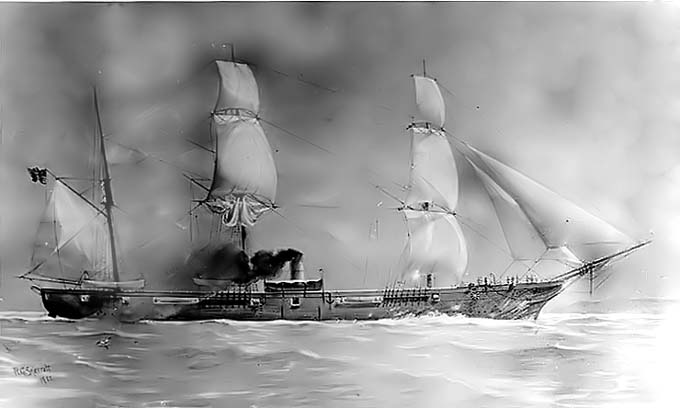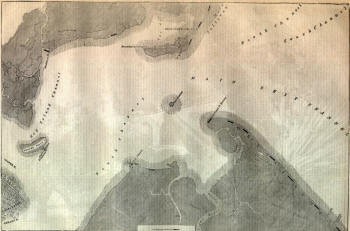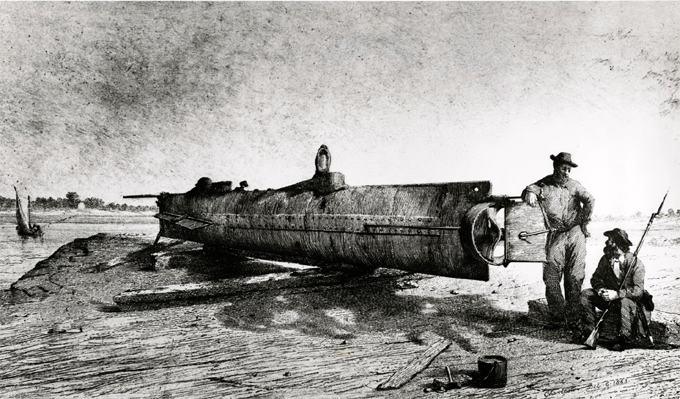|
By presenting this article, we are hoping to whet
your appetite for more information about the little ship that changed
the world of warfare. The Civil War produced many “firsts” on the
battlefield and at sea. Hunley was an American first, from its inception
in 1862 to the sinking of the Housotanic in 1864, the discovery of its
resting place in 1970, verification of the site in 1997, the salvage and
return home to Charleston in 2000. Although Hunley had no impact on the
outcome of the war, the sinking of the Housatonic and Hunley’s
subsequent disappearance created a legend that actually had the Union
blockading forces concerned that the South had more
of these little boats.
HUNLEY BACKGROUND
From its earliest beginnings, the world’s militaries
have sought ways to explore and exploit the oceans’ surface and depths
to gain advantage over their adversaries. These included improving on
designs for people to go under water for prolonged period. The
well-known sketches of Leonardo DaVinci included such ideas. During the
American Revolution, David Bushnell created a submersible named Turtle,
attempting to sink a British Man of War by attaching an explosive charge
to its hull; an attempt that failed. But it was Horace Hunley and his
associates who produced the first militarily successful submersible
during the American Civil War. While other designers and builders, such
as John Holland and Simon Lake would improve upon the designs and later
builders would perfect them, Hunley, remarkably, was the first the have
a design sufficient to sink a major man-of-war and insofar as it is
possible to ascertain, escape enemy retaliation.

Sullivan's Island at the time of the Hunley Expedition
The project to design and build a submersible boat
capable of attacking a surface ship started in February 1862 when a
group of
New Orleans businessmen became inspired by the concept of a
combat submarine presented to them by James McClintock and Horace L.
Hunley.
Using their own money as well as monies from
investors, McClintock and Hunley began construction of the submersible in
New Orleans. As Southern patriots, they wanted to help the Confederacy
break the blockade of southern ports by sinking or capturing Union
blockaders and, as businessmen, earn a profit doing so. Thus it came
about that the first operational attack submarine would be a
“privateer”.
McLintock and Hunley’s first attempt resulted in a
craft they called Pioneer. After several successful trial runs in
Lake Pontchartrain, Pioneer showed that she was capable of diving and moving
underwater, however several significant defects made her unsuitable for
the mission. As Union forces were moving to capture New Orleans, Pioneer
was scuttled in a deep cut of the lake to keep her from being taken by
the enemy. The project to build a submarine moved to Mobile, Alabama.
This area was relatively safe from Union forces in part due to the
natural protection afforded by Mobile Bay. At Mobile, they obtained the
services of a machine shop owned by Thomas Park and Thomas Lyons.
Fortune was in their favor. Two of the men working in the Park and Lyons
shop were William Alexander a master machinist and George Dixon, a
recently promoted Lieutenant in the Confederate Army whose mechanical
talent was noted by his superiors who sent him to work at the shop
building new weapons.
The second boat had improved features over the first
since Mclintock had noted every defect of the Pioneer and made
corrections to the design to overcome the defects. The second boat named
American Diver made several trial runs in Mobile Bay that encouraged the
builders to plan an attack on Union ships off Sand Island, outside the
Bay.
To expedite the trip to their target, American Diver
was to be towed to a point near Sand Island and then submerge for the
attack. The kill method was an explosive charge on a rope trailed behind
them on the surface. The idea was to pass under a Union ship thus
pulling the explosive charge against the Union ship.
Unfortunately, as Diver was being towed to a position
closer to the target, it suddenly submerged and sunk. Thus, the second
attempt to build a successful submarine had failed. But McLintock and
Hunley did not give up.
As the story unfolds, the project persisted to build
a third and more successful model called Fishing Boat or Porpoise which
incorporated sleek lines and improved engineering in its design. This
was the boat destined to add a new and terrifying chapter to the history
of naval warfare. The boat was renamed H. L. Hunley after the
designer-builder died in the second sinking of this boat in Charleston
Harbor.
THE ADVERSARY – USS HOUSATONIC
In February 1864, the Union naval blockade was
strangling the Confederacy and, as a major port,
Charleston, South
Carolina, was a primary point of embarkation and debarkation for the
Southern blockade runners. Food and other commodities including weapons
and ammunition were in short supply.
Among the blockading ships was the USS Housatonic, a
steam and sail driven man-of-war, launched in 1861, with a crew of 160.
With a top speed of 9 knots, she weighed 1,240 tons with a length of 207
feet, a beam of 38 feet and a draft of 8 feet 7 inches. Housatonic’s
armament consisted of 1 100-pounder Parrott rifle, 3 30-pounder Parrott
rifles, 1 11"
Dahlgren smoothbore, 2 32-pounders, 2 24-pounder
howitzers, 1 12-pounder howitzer, 1 12-pounder rifle.

The USS Housatonic: The First Ship
Sunk by a Submarine
During the Housatonic’s tour of duty with the Union blockade, she
participated in shore bombardment of a number of Confederate
installations and received credit for the capture of some Southern
blockade runners and assisting in the capture or destruction of several
others. Housatonic’s war record was a credit to her officers and crew,
but her place in history was confirmed when she became the first ship
ever sunk by submarine action.
 On the evening of 17 February, the Housatonic moved out of the line of
blockading ships into shallow water off Charleston Harbor in order to
catch enemy blockade runners. At
approximately 8:45 PM, the Officer of the Deck, LT John Crosby, noticed
something moving through the water towards the Housatonic and thought
that it was either a porpoise or a log. By the time he realized his
error, Hunley was too close to be engaged by Housatonic’s guns and,
although evasive action was attempted, Hunley rammed its torpedo into
Housatonic’s hull. Backing off, Hunley triggered the torpedo which set
the Housatonic on fire setting off an explosion that blew off the aft
starboard quarter of the ship, sinking the Union vessel within five
minutes of the original attack. The Housatonic went down in about 27
feet of water with the loss of five crew members. On the evening of 17 February, the Housatonic moved out of the line of
blockading ships into shallow water off Charleston Harbor in order to
catch enemy blockade runners. At
approximately 8:45 PM, the Officer of the Deck, LT John Crosby, noticed
something moving through the water towards the Housatonic and thought
that it was either a porpoise or a log. By the time he realized his
error, Hunley was too close to be engaged by Housatonic’s guns and,
although evasive action was attempted, Hunley rammed its torpedo into
Housatonic’s hull. Backing off, Hunley triggered the torpedo which set
the Housatonic on fire setting off an explosion that blew off the aft
starboard quarter of the ship, sinking the Union vessel within five
minutes of the original attack. The Housatonic went down in about 27
feet of water with the loss of five crew members.
According to various reports, Hunley then displayed a blue lamp towards
shore signifying mission success and was returning to port. The
Confederate lookout lit a bonfire to guide the victorious submarine
home, but the H. L. Hunley disappeared in the night, not seen again for
137 years.
THE CONSTRUCTION OF H. L. HUNLEY
To counter the Union blockade, the South had already
constructed a small fleet of
semi-submersible torpedo boats called
“Davids” which sat very low in the water and attacked Union ships with
varying success. Although there is no record of the Davids successfully
sinking a blockader, these little craft and numerous ironclads (most
famous of which is the CSS Virginia) attempted to clear the blockade in
order to expand commerce with Europe.
The plans for the submersibles called for either steam or battery driven
engines, but the builders were unable to build an engine that would
provide the necessary power and had to resort to manpower for
propulsion. The first attempts, Pioneer and American Diver, ended in
failure, the Pioneer scuttled in Lake Ponchartrain to avoid capture by
Union forces and the American Diver sinking in Mobile Bay. The Diver was
subsequently recovered, studied by Union forces, and then sold for
scrap.
One of the stories about the construction of the
Hunley is that her builders used a railroad boiler 48 inches in diameter
and twenty-five feet long. The boiler was cut in half lengthwise and two
12 inch boiler iron strips on either side increasing the diameter
approximately 60 inches. She was lengthened by about five feet, tapered
fore and aft with bow and stern castings attached. However, when the
Hunley was raised in 2000, archeologists found that she was constructed
of iron plates riveted to a purposely constructed frame tapered fore and
aft to provide “streamlining” allowing her to move fairly easily under
the surface of the ocean. The final configuration was about 30 feet
long, 4 feet wide and 5 feet deep. The plan to use steam or battery
power was not realized and a hand crank was installed to provide
propulsion. A tiller provided direction for the little ship. Ballast
consisted of iron bars bolted to the bottom of the hull and tanks at
either end which could be opened manually to allow Hunley to submerge.
Hand operated pumps were used to expel water to allow her to surface.
Her armament was a torpedo (also known as a mine) at the end of a 20
foot spar extending from the bow. The torpedo was placed by ramming the
victim, penetrating the hull, then backing off, using a long cord to
trigger the explosive.
THE OPERATION
While the Hunley was being developed,
General P.T.G.
Beauregard, the Confederate Commander of Charleston, SC was trying to
clear the Union blockade of Charleston Harbor. He appealed for
assistance and Hunley was dispatched to attack the enemy forces cutting
off shipping.
To move Hunley, she was cut in half, loaded on railcars and camouflaged
for the journey from New Orleans to Charleston to continue preparations
and training to face the Union forces. One interesting point is that
during her entire career, Hunley was operated by the Confederate Army
(not the Navy) and in her short life, sank twice with the loss of most
personnel even before meeting the enemy. The first sinking happened when
she was swamped by a tender pulling away from the little ship. There
were three survivors. The second accident took the lives of the entire
crew including that of H. L. Hunley, one of her inventors, when she
submerged, rammed the bottom of Charleston Harbor, and became stuck.
Because of these two accidents and the loss of nearly two complete crews
(approximately 16 men); General Beauregard placed restrictions on Hunley
requiring her to operate as a surface ship.
CHRONOLOGY: Confederate Naval
Victories
In 1864 when the H. L. Hunley sank the Union
blockading ship USS Housatonic, the war was going poorly for the
Confederacy. Union forces were slowly advancing on all fronts and the
Confederate States were being squeezed into a smaller and smaller area
of operations. Although the Union blockade of Southern ports against
overseas commerce was fairly tight, the South was somewhat successful at
sending fast cargo ships through the encircling warships and Confederate
naval vessels scored numerous victories including those of the commerce
raider
CSS Alabama (69 Union vessels sunk or captured) until the USS Kearsarge destroyed her in June off Cherbourg, France. Among the
Southern successes were:
2 February, 1864
Confederate boat expedition led by Commander J. T.
Wood captured and destroyed USS Underwriter in the Neuse River, North
Carolina.
17 February, 1864
Confederate submarine H. L. Hunley sank Union
blockader USS Housatonic off Charleston -- the first submarine to sink a
ship in combat.
12 March, 1864
Ships of Rear Admiral D. D. Porter's Mississippi
Squadron moved up the Red River to commence the unsuccessful Army-Navy
campaign to gain a foothold in the Texas interior.
19 April, 1864
CSS Albemarle, Commander J. W. Cooke, sank USS
Southfield and forced the remainder of the Union squadron at Plymouth,
North Carolina, to withdraw. Having gained control of the waterways in
the area, the Confederates were able to capture Plymouth on 20 April.
5 May, 1864
USS Sassacus, Wyalusing, and Mattabesett engaged CSS
Albemarle off the mouth of the Roanoke River as the Union sought in vain
to regain control near Plymouth.
6 May, 1864
Confederate torpedo destroyed USS Commodore Jones in
the James River, Virginia, one of several losses the Union suffered from
torpedoes during the year.
IN MEMORIUM
A total of 21 sailors died in the three sinkings of
the H.L. Hunley. The Union forces lost five sailors in the sinking of
the USS Housatonic.
The Hunley crew members are buried at the Magnolia Cemetery in
Charleston, S.C.
Crew List for the H.L.Hunley
(Also listed are those who survived)
Sinking #1 - 29 August 1863
Payne, Lt John - Commanding – survived
Hasker, Charles - Seaman - survived
Williams, Absolum – Seaman
Cane, Michael – Seaman
Davis, Nicholas – Seaman
Doyle, Frank – Seaman
Kelly, John – Seaman
Sprague, Charles – Seaman – survived - (Some accounts list Sprague as
the third survivor of this tragedy although other accounts state that
this survivor was unknown.)
Sinking #2 - 15 October 1863
Hunley, Horace L. - Commanding and one of the builders
Beard, Henry – Seaman
Brookbank, Robert – Seaman
Marshall, John – Seaman
McHugh, Charles – Seaman
Parks, Thomas W. - Designer and builder
Patterson, Joseph – Seaman
Sprague, Charles L. - Seaman
Sinking #3 - 17 February 1864
Dixon, Lt George - Commanding
Becker, Arnold - Seaman
Carlsen, J.F. – Seaman
Collins, Frank – Seaman
Miller, Augustus - Seaman
Ridgeway, Joseph - Seaman
Simkins (Lumpkin?), C. – Seaman
Wicks, James A. - Seaman
Crew Members Lost with the USS Housatonic
Hazeltine, Ensign E. C. – Ship’s Officer
Williams, John - Quartermaster
Walsh, John - Fireman Second Class
Parker, Theodore - Landsman
Muzzey, Charles O. – Yeoman
REFERENCES
H.L. Hunley in Historical Context, Rich Wills, former
Assistant Underwater Archaeologist, Naval Historical Center, 805 Kidder
Breese SE, Washington Navy Yard, Washington, DC 20374-5060
www.history.navy.mil
The Civil War Book of Lists, Donald Cartmell, New
Page Books, The Career Press, 3 Tice Road, PO Box 687, Franklin Lakes,
NJ 07417 www.newpagebooks.com
Raising The Hunley, The Remarkable History and
Recovery of the Lost Confederate Submarine, Brian Hicks and Schuyler
Kropf, A Presido Press Book
www.presidiopress.com
Find A Grave.com – The Hunley Submarine Crew
 Also
See this Fascinating
Rebel Submarine predating the Hunley in this January 30, 1864
Harper's Weekly Also
See this Fascinating
Rebel Submarine predating the Hunley in this January 30, 1864
Harper's Weekly
|




